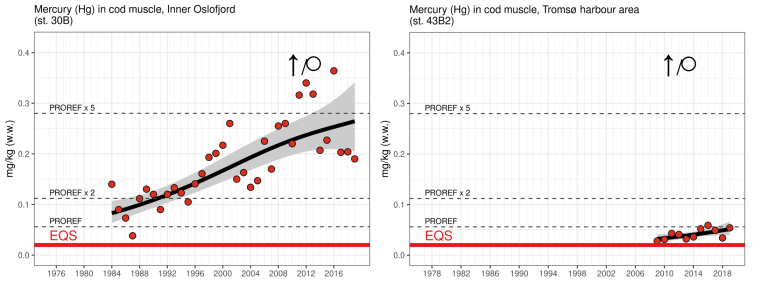
Lower levels of contaminants along the Norwegian coast – but still high concentrations of mercury in cod in some urban areas
The Norwegian Institute for Water Research (NIVA) are monitoring levels, trends and effects of various contaminants in blue mussel, cod, flatfish, snails and eider duck on behalf of the Norwegian Environment Agency. The monitoring program started in 1981, and provides a yearly status of many fjords and coastal waters along the Norwegian coast and at Svalbard. The report for the 2019 data is now published.
– The levels of contaminants mainly decrease in the marine environment, but there are examples of higher levels in the harbour areas of the Inner Oslofjord as well as Kristiansand, Bergen, Trondheim and Bodø, says researcher at NIVA Merete Schøyen.
Monitoring includes analyses of metals (e.g. mercury, copper, lead, zinc, cadmium), tributyltin (the antifouling agent TBT), organochlorides (e.g. PCBs, the insecticide DDT, the combustion product HCB), tar substances (PAHs), brominated flame retardants (PBDEs), perfluorinated alkylated substances (PFAS), chlorinated paraffins (SCCP, MCCP) and siloxanes (D4, D5 and D6).
Increasing long-term trends for mercury in cod
In the Inner Oslofjord, many contaminants continue to have relatively high concentrations. Mercury is one of these, and an upward long-term trend (1984-2019) was observed for this contaminant in cod fillet. However, considering the past 10 years, no trend was detected. At Steilene and Tjøme, in the Inner and Outer Oslofjord, respectively, the concentrations of mercury in cod fillet were up to five times higher than the reference value (Norwegian provisional high reference contaminant concentration, PROREF) calculated for the monitoring program.
Since the monitoring started, slightly larger and older cod have been caught. However, even when correcting results for the change in size (which corresponds to change in age), only a minor increase in concentrations was found.
The long- and short-term trends for mercury in cod fillet are also upward in Kristiansand, Farsund and Bømlo, and in Tromsø there was also a long-term upward trend. The concentrations of mercury in cod found in 2019 also exceeds EU’s Environmental Quality Standard (EQS) of 0.02 mg mercury per kg fresh weight, which defines the upper limit for the classification of good chemical status. However, the median concentrations of mercury in cod at all stations are lower than the limit value for seafood (0.5 mg mercury per kg cod).
– Possible explanations for upward mercury trends in cod in some places may be related to factors such as climate change, which can lead to increased precipitation and greater runoff to the fjord, which in turn provides more favorable conditions for the formation of methyl mercury, increased bioavailability of mercury stored in sediments, increased access to contaminated grazing areas for cod due to improved oxygen levels in deep water, and changes in what cod eats, says Merete Schøyen.

Differences of PFAS in the Oslofjord
Perfluorinated alkylated substances (PFAS) are contaminants of special concern, since they accumulate in organisms, are toxic and have a long degradation time. PFAS is on the EUs list of priority substances. The compounds have water and stain repellent properties and have for example been used for impregnating textiles, as coating in frying pans and in ski preparation. It has also been used in fire-fighting foam and can therefore often be found near areas used for fire drills, e.g. at airports.
PFAS has been monitored regularly in cod liver in many fjords since 2005. Perfluorooctanesulfonic acid (PFOS) and perfluorooctanesulfonamide (PFOSA), both common PFAS compounds, are highest in cod liver from the Inner Oslofjord. In 2017 and 2019 there were no exceedances of the reference value (PROREF) for PFOSA in cod liver from Tjøme, compared with an exceedance between five and ten times in 2018.
– The differences in levels from different areas in the Oslofjord cannot yet be fully explained, but it is likely that a combination of urban sources and limited water exchange gives higher concentrations in the Inner Oslofjord, says senior researcher at NIVA Norman Green.
Supplementary studies showed no statistical correlation between these two substances in cod liver with distance to the nearest airport, but the results indicate that the concentrations decrease northwards along the coast.
These long-term studies provide a basis for capturing changes in the environment over time and for documenting the effects of environmental measures, which in turn strengthens the basis for good management. The results from this project are part of Norway’s contribution to the OSPAR Convention (originally the Oslo and Paris Conventions) and the EU through the Water Framework Directive. The data is also sent to the Norwegian Food Safety Authority as a basis for assessing the need for local warnings regarding consuming certain types of seafood.
 Merete Schøyen
Merete Schøyen